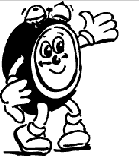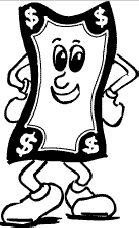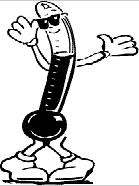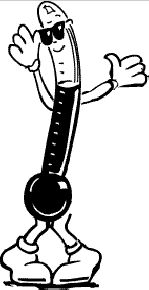If you've got the
TIME,
I've got the
MONEY,
Especially if the
TEMPERATURE
is right!
Eileen Danylczuk
St. Angela Merici School
Regina, SK.
_________________________________
1. Introduction and Overview
This document seeks to provide user-friendly suggestions for primary teachers of mathematics.
Three sub-topics of the measurement strand of the new elementary mathematics curriculum guide
are covered. Parts of this document have been adapted freely from "Mathematics: A Curriculum
Guide for the Elementary Level".
Each sub-topic (Time, Money, Temperature) has several lessons. Teachers are invited to peruse
the list of suggestions and select appropriate lessons for their particular classrooms.
The measurement strand makes up only 15% of the entire mathematics curriculum, and each sub-topic is only a small portion of the entire strand. Consequently, teachers are reminded that the
content of these three sub-topics is frequently taught, not as a complete unit in itself, but all
through the year, every year, for many years. Thus, the content, while sequential in nature, is
taught incidentally and directly, and requires continual review and re-teaching.
2. Evaluation
Evaluation, for purposes of this unit, is to determine what has been taught - and the natural
corollary is to improve instruction, monitor student progress, and show areas where re-teaching
may be required.
Since mainstreaming is an educational reality in today's classrooms, evaluation and assessment
often need to be individually adapted. As well, measuring student progress requires a variety of
techniques.
In the primary grades, evaluation and assessment is an on-going, continuous, often informal,
process. Data may be gathered through anecdotal records and by checklists. The assessments
may be taken prior to formal teaching, during and after; for comparison purposes. Assessment
stations are used more often today as the idea of learning centres becomes prevalent.
Formal testing may also be employed and includes such techniques as pencil and paper quizzes,
and oral assessment. Performance tests can be particularly useful since the emphasis of the new
curriculum is activity-based and manipulative.
[Duration: Approximately one week]
From the following list, choose lessons that best suit your learning objectives and the individual
needs of your students. Realize and appreciate the fact that the teaching of time goes on
incidentally all year, for several years.
- Begin the school year by counting off the days as they occur. Introduce the idea of the
"Hundred Day Party". Plan to teach this unit during the week that the one hundredth day of
the school year will occur.
- Use a selection of children's literature titles related to time such as Eric Carie's Grouchy
Ladybug (see Bibliography). Concentrate on durations of one minute by solving a variety of
one minute problems such as "How many times can you bounce a ball in one minute?", "How
many addition questions can you do in one minute?", "How long is one minute?", or "Put your
head up when you think one minute has passed."
- Construct a classroom timetable on the chalk board and add to it as the day and week
progress.
- Sequence a variety of events in pictorial form. Some suggested ideas are: photographs of
people aging, trees or other plants changing according to the seasons, steps to making popcorn
or a cake, etc.
- Construct simple analog clocks with paper plates, paper hands, and a brass paper fastener.
- Construct simple digital clocks with strips of numbered papers wrapped around cylinders such
as tin cans.
- Research and discuss the history of time pieces and clocks.
- Provide a display of a large variety of time measurement devices.
- Provide clock-face stampers for children to use at a learning centre.
- Prepare cooperative learning games such as The Same Time or Hickory Dickory Dock (both
from Addison-Wesley Mathquest 1)
- Make posters or charts that record the passage of time such as MY DAY, A YEAR IN THE
LIFE OF (student's name), and so on.
- Play clock BINGO with clock faces instead of numbers.
- Integrate a lesson on contractions using o'clock as an example.
- Sequence a week in a student's life highlighting various activities for each day of the week.
- Collect data on the children's birthdays and graph the results.
- Visit the same outdoor part or location four times (September, December, March, and June).
Observe and record details regarding seasonal changes.
- Collect and display various calendars, daybooks, appointment books.
- Choose a sunny day and location to construct an easy sundial with a pole and rocks. Measure
hourly and use rocks as indicators.
- Learn the verse "Thirty days hath September, April, June and November, and all the rest have
thirty-one, except, February having 28. But Leap Year coming once in four, February then
hath one day more".
- Learn the verse "Monday's Child is fair of face, Tuesday's child is full of grace, Wednesday's
child is full of woe. Thursday's child has far to go, Friday's child is loving and giving,
Saturday's child works hard for a living, and a child that's born on the Sabbath day is blithe
and bonny and good and gay".
- Learn the verse "Solomon Grundy; born on Monday; christened on Tuesday; married on
Wednesday; took ill on Thursday; worse on Friday; died on Saturday; buried on Sunday.
This is the end of Solomon Grundy".
- Do activities in the gym or outdoors which can be timed with a stop watch.
- Prepare cardstock sets of cards for the months of the year; the days of the week, hours in a
day, etc. Students can order these.
- Complete this chart every day:
Today is ____________.
Yesterday was _________________.
Tomorrow will be _________________.
- Flip coins a given number of times. Discuss heads, tails, and the probability of the results.
- Play "What time is it Mr. Wolf?" or similar-type games during Physical Education.
- Discuss day, night, tomorrow, today, yesterday, morning, afternoon, evening.
- Make pendulums of differing lengths. Time the swing and compare results. Show a
metronome from the music department.
- Make a huge clock in the gym using students holding posters stating 1:00, 2:00, etc., and two
brooms of differing lengths for clock hands.
- Collect data regarding the number of clocks in each student's home, and graph the results.
- Estimate the amount of time required to perform some task such as stacking blocks. Then, do
the activity and actually time it; see who was able to estimate closest to the right time.
- Run a string or wire below the chalk board ledge. Use it with photographs or pictures and
clothes pines - a "real" time line.
- Make large puzzle pieces on cardstock of three or four representations for the same time.
Laminate.
- Conclude the unit with a "Hundred Day Party" on the actual hundredth day of the school year.
Celebrate with 100 minutes of fun, 100 minutes of movies, 100 jelly beans, 100 ounces of
drink, and so on.
* Return to Table of Contents
[Duration: Approximately one week]
From the following list, choose lessons that best suit your learning objectives and the individual
needs of your students.
- Introduce the topic of money with children's literature titles such as Alexander Who used to be
Rich Last Sunday, or Matthew and the Midnight Money Van (see Bibliography.
- Play detective and use a magnifying glass to examine a collection of real coins stored in a cloth
bag or change purse.
- Provide opportunities for the children to see, manipulate, count and compare actual coins and
paper money. Note colors, shapes, thicknesses, relative sizes, estimated and real weights, and
values.
- Discuss and research the history of money including bartering, minting, the introduction of the
loon dollar, and so on.
- Show traditional dollar bills and compare with a loon dollar. Discuss why we have moved to
the loon or "loonie".
- Coins can be mounted with rubber cement onto cardstock. The cards can be laminated as well.
Use for demonstration purposes or in station activities.
- Develop a poster by mounting coins and bills, labeling their value, and laminating.
- For interest's sake, show collections of foreign coins or invite a coin collector to visit the class
and discuss his/her hobby.
- Provide opportunities for students to manipulate, count, and classify coins in sorting trays.
(An egg carton works well too).
- Research the history and origin of "Piggy Banks". Display a collection of same.
- Do rubbings of various coins using colored chalk or crayons. These can also be enlarged on
the photocopier for an interesting display.
- After students have had the opportunity to examine real coins, provide play money which is
very realistic and inexpensive today.
- Students can stack coins and compare values, and graph the results.
- Teach the symbol "$" and provide kinesthetic opportunities for the students by cutting the
symbol out of sandpaper, felt and so on.
- Solve a variety of problems that deal with realistic money questions. "How much...." type
questions allow practice with adding and subtracting varying amounts of money. Advance to
making change.
- Discuss point-of-sale electronic terminals such as the ones children are already seeing when
their parents pay for groceries, and other purchases.
- A field trip might include an excursion to a nearby grocery store where products and prices
could be compared (integrated with health nutrition lessons).
- A field trip might include a tour of a banking institution. Children would enjoy seeing the
vault, safety deposit boxes, etc.
- Visit an automated banking machine (ATM) and demonstrate its use.
- Discuss cheques - both paycheques and those used to pay for items. Incorporate this
incidentally when children bring cheques for school fees, etc.
- Discuss various charge cards and the manner in which they are used.
- Make a bar graph of student allowances. Discuss how allowances are spent.
- Overheads of money can be made using picture representations.
- Bulletin boards can feature pictures and prices which can be incorporated into realistic
problems for use during the unit.
- Remember that money concepts evolve from simple to sophisticated and need to be revisited
frequently throughout the school year.
- Use catalogue pictures or newspaper advertisements to discuss realistic money problems.
- Build towers of coins of different denominations up to $1.00, $2.00, and $5.00.
- Use Coin stampers to show "How much".
* Back to Table of Contents
[Duration: Approximately one week]
From the following list, choose lessons that best suit your learning objectives and the individual
needs of your students. Realize and appreciate that much of this topic can be taught incidentally
throughout the school year, for several years.
- have a pictorial weather chart pasted up permanently and discuss it daily.
- Discuss temperature daily by having the children become aware of the temperature before they
leave for school.
- Discuss "wind chill factor", especially during periods of "indoor recess".
- Make the children aware of temperature by using children's literature titles such a Robert
Munsch's 50 Below Zero (see Bibliography).
- visit the same park or location four times during the school years (September, December,
March, and June). Discuss seasonal temperatures, etc.
- Make a metre high thermometer our of heavy cardboard and red ribbon. Use it daily in your
classroom.
- Make student-size thermometers similar to the metre-high class thermometer. Use these for
oral questioning and evaluation.
- Display a wide variety of thermometers - alcohol thermometers of all descriptions, meat or
cooking thermometers, round (metal spring) outdoor or window thermometers, oral, rectal
medical thermometers, and so on.
- Set up stations where children can measure warm, cool, hot, and cold water, as well as buckets
containing ice and snow.
- Make ice cream using cream in a small container inside a large container packed with snow and
sprinkled liberally with salt. Measure the temperature of the snow/salt combination frequently
throughout the experiment.
- Discuss heat sensitive objects such as "Hyper-color" t-shirts, etc.
- Make seasonal charts with magazine pictures to indicate average temperatures, activities, etc.
- Graph temperatures over a designated period of time - could be hourly over a single day, or at
the same time of day for a week or a month.
- Visit the furnace room of your school. Discuss class thermostat, observe duct work.
- Show and discuss a power bill. Discuss methods of heating a home - gas, oil, electric, wood,
etc.
- Estimate the temperature. Check your estimates with an accurate reading or report.
- Discuss health-related issues - average (body) temperature, fevers, etc.
- Discuss why a dog or other furred animal pants.
- Discuss weather "forecasts" and weather "reports".
- Watch weather reports on TV or listen on the radio. Incorporate map skills.
* Back to Table of Contents
Resources -
Some Suggestions
|
|
|
TIME
|
MONEY
|
TEMPERATURE
|
- pictures
- 12 hour clocks
- digital clocks
- analog clocks
- clock stamps
- stop watch
- calendars
- watches
- sand-time/egg timer
- sundial
- magazines
- paper plates
|
- real money
- play money, coins and
bills, up to $10.00
- money stamps
- cash register
- overhead transparencies of
money, coins
- a variety of items to "play
store"
- catalogues
|
- pictures of seasons,
activities, dress
- non-standard thermometer
- bowls
- thermometers - indoor,
outdoor, dipping, blank,
picture
- containers
- ice-snow, warm, and cold
water
|
* Back to Table of Contents
CURRICULUM:
Scope and Sequence
Time
|
 | |
Grade 1
|
Grade 2
|
Grade 3 |
Students should be able to:
- solve a variety of problems
involving time
- identify longer/shorter
periods of time using non-standard units
- determine the length of
time (non-standard units)
using a variety of simple
"clocks"
- understand the concept of
time by using a digital
clock (hour), and 12 hour
clock (hour, half hour)
- Order events according to
time
- Understand and explain:
* 24 hours = 1 day
* 30 days = 1 month
* 7 days = 1 week
*12 months = 1 year |
Students should be able to:
- solve a variety of problems
involving time
- understand the concept of
time by using a digital
clock (minute), and a 12
hour clock (quarter hour,
five minutes)
- order events according to
time
- understand and explain:
* 30 days = 1 month
* 60 minutes = 1 hour
* 12 months = 1 year |
Students should be able to:
- solve a variety of problems
involving time
- understand the concept of
time by using a 12 hour
clock (minute, second)
- estimate events according
to time
- understand and explain:
* 60 seconds = 1 minute
* 365 days = 1 year |
CURRICULUM:
Scope and Sequence
MONEY
|
 | |
Grade 1
|
Grade 2
|
Grade 3
|
Students should be able to:
- solve a variety of problems
relating to money
- identify coins/bills up to
one dollar
- understand the relationship
between pennies, nickels,
dimes.
- count with pennies,
nickels, and dimes
|
Students should be able to:
- solve a variety of problems
relating to money
- identify coins/bills up to
ten dollars
- understand the relationship
between quarters and
dollars
|
Students should be able to:
- solve a variety of problems
relating to money
- identify coins/bills up to
one hundred dollars
- count with two dollars,
five dollars, and ten dollars
- use strategies to make
change for given values to
five dollars
- add and subtract amounts
of money using ccrrect
symbols for cents and
dollars
|
CURRICULUM:
Scope and Sequence
Temperature
|
 | |
Grade 1
|
Grade 2
|
Grade 3
|
Students should be able to:
- solve a variety of problems
involving temperature
- compare temperatures
using terms such as
"hotter", "older",
"warmer", or "cooler"
|
Students should be able to:
- solve a variety of problems
involving temperature
- compare temperatures
using terms such as
"hotter", "colder",
"warmer", or "cooler"
- compare and estimate,
then read a thermometer
and record in degrees
Celsius
|
Students should be able to:
- solve a variety of problems
involving temperature
- compare and estimate,
then read a thermometer
and record in degrees
Celsius
- use environmental signs to
estimate temperature
|
* Back to Table of Contents
Common Essential Learnings and Foundational Objectives
For Teaching Time, Money, and Temperature
|
Numeracy
- use measurement tools
and devises accurately.
- collect data.
- record data.
- graph data.
- count and compare bills
and coins.
|
Technological Literacy
- trace the historical
evolution of measurement
tools for time and
temperature.
- trace the historical
development of minting
coins.
- discuss the evolution of
banking as we know it
today.
|
Communications Skills
- develop measurement
vocabulary.
- listen attentively.
- follow instructions.
- organize information.
- make predictions.
- share personal
experiences.
- participate in group
discussions and activities.
|
Critical and Creative
Thinking
- brainstorm ideas,
vocabulary.
- classify information.
- discover relationships.
- explain, create, predict
information.
- compare and contrast
data.
- evaluate.
|
Personal and Social
Skills and Values
- share personal experiences.
- respect differences.
- demonstrate cooperate
work techniques.
- develop a personal sense of
responsibility towards the
use of money.
|
Independent Learning
- work alone, in pairs, in
small groups, and in large
groups.
- organize personal time,
space, and materials.
- collect data.
- relate new knowledge to
prior knowledge.
- evaluate program.
|
Beesey, C., and Davie, L. (1992). Gage active mathematics level 1 (K-2). Toronto, ON: Gage
Educational Publishing Co.
Carle, Eric (1977). The grouchy ladybug. NY: Thomas Y. Crowell Company.
Cleary, B. (1960). The real hole. NY: William Morrow Books.
Coombs, B., & Harcourt, L. (1986). Explorations 1. Don Mills, ON: Addison-Wesley
Publishers.
Darling, K. (1972). The jelly bean contest. Toronto, ON: Thomas Nelson and Sons Canada,
Ltd.
Drobot, E. (1987). Everything you want to know about money: An amazing investigation.
Toronto, ON: Greey de Pencier Books.
Edmonds, J., & Sachner, M. (1985). Time! Milwaukee, : Gareth Stevens Publishing, Inc.
Fice, R.H.C., & Simkis, I. M. (1966). Time and clocks (Wee discover series). Leeds, : Arnold
and Sons, Ltd.
Giff, P, R. (1980). Today was a terrible day. NY: Viking Press.
Ginsburg, M. (1981). Where does the sun go at night? NY: Greenwillow Books.
Lac La Ronge Indian Bank. (1985). The six seasons of the woods cree. [Poster]. Available: Lac
La Ronge Indian Band, Education Branch, Curriculum Resource Unit, Box 1410, La Ronge,
SK., S0J 1L0, (306) 425-2183.
Liewellyn, C. (1992). My first book of time. Richmond Hill, ON: Scholastic Canada, Ltd.
Maestro, B. (1990). Temperature and you. NY: Lodestar Books.
Mathquest 1, Mathquest 2, Mathquest 3. (1989). Don Mills, ON: Addison-Wesley Publishers.
McInnes, J., & Murray, W. (1975) Telling the time. Don Mills, ON: Thomas Nelson and Sons
(Canada) Ltd.
Mitgutsch, A. (1985). From gold to money: A start to finish book. Minneapolis, MN:
Caroirhoda Books, Inc.
Morgan, A. (1987). Matthew and the midnight money van. Toronto, ON: Annick Press Ltd.
Rahn, J. E. (1983). Keeping warm, keeping cool. NY: Atheneum.
Richardson, J. (1992). Day and night. NY: Franklin Watts.
Saskatchewan Education. (March, 1992). Mathematics: A bibliography for the elementary
level. Suitable Titles:
- Big time bears.
- Completed hickory, dickory, dock.
- Exploring measure, time, and money: Level I, II, and III [Software].
- The guy who was five minutes late.
- It's about time.
- Lemonade Parade.
- Math, money, and you.
- Old enough.
- Telling time.
- This book is about time.
- Time.
- Time, lines, and events.
- Time to....
- Understanding mathematics five.
- Windows on mathematics: Money and time.
*** Complete bibliographic information available in reference document ****
Short, C. (1989). Art for the Awasisak: The incorporation of Woodland Cree art, history, and
culture into the Alberta Elementary Art Curriculum. Available: Alberta Teacher's
Association.
Thaler, M. (1980). My puppy. NY: Harper and Row Publishers.
Troutman, A. P., & Lichtenbert, B. K. (1991). Mathematics: A good beginning - Strategies for
teaching children (4th ed). Don Mills, ON: Thomas Nelson and Sons (Canada) Ltd.
Viorst, J. (1978). Alexander, who used to be rich last Sunday. NY: Atheneum.
William, V. B. (1984). Music, Music for Everyone. NY: Greenwillow Books.
This unit comes from the The Stewart Resources Centre which provides
library resources and teacher-prepared materials for teachers in Saskatchewan.
To borrow materials or obtain a free catalogue listing unit and lesson
plans contact :
Stewart Resources Centre,
Sask. Teachers' Federation,
2317 Arlington Avenue,
Saskatoon, SK S7J 2H8;
phone 306-373-1660; fax 306-374-1122,
e-mail src@stf.sk.ca.
http://www.stf.sk.ca/
Go to Math Central
To return to the previous page use your browser's back button.
 3. Time - Suggested Lesson Ideas
3. Time - Suggested Lesson Ideas 3. Time - Suggested Lesson Ideas
3. Time - Suggested Lesson Ideas 4. Money - Suggested Lesson Ideas
4. Money - Suggested Lesson Ideas 5. Temperature - Suggested Lesson Ideas
5. Temperature - Suggested Lesson Ideas


